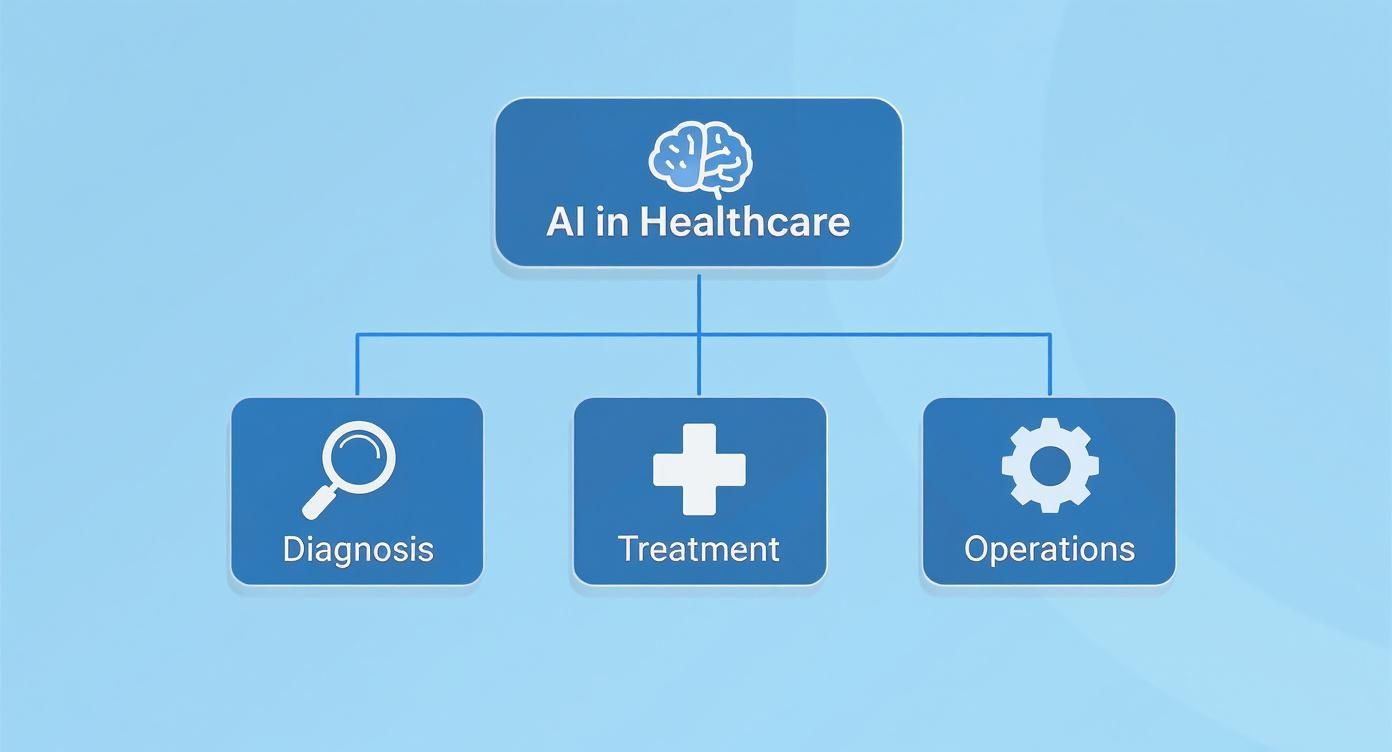AI Solutions for Healthcare That Improve Patient Care
When we talk about AI solutions for healthcare, we’re not just talking about futuristic robots. We’re talking about smart systems designed to sift through mountains of complex medical data. Their goal is to support clinicians, make hospital operations run smoother, and speed up vital research.
Think of these tools as a powerful partner for medical professionals, helping with everything from spotting diseases earlier than ever to tailoring treatments specifically for an individual patient. This isn’t just a minor update to the system; it’s a fundamental change in how we approach healthcare.
How AI Is Reshaping Modern Healthcare
Artificial intelligence has officially moved out of the research lab and into the clinic. It’s now a practical, powerful force that’s actively improving patient outcomes and making hospitals more efficient.
Imagine giving a doctor a super-powered assistant that can spot subtle patterns in data the human eye might miss. That’s essentially what AI does. Technologies like machine learning and natural language processing are now woven into daily clinical work. They help radiologists interpret complex scans, predict which patients are at high risk for certain conditions, and even handle the tedious administrative work that eats up a doctor’s day. This frees up clinicians to do what they do best: care for patients.
This visualization breaks down the main areas where AI is making a real difference.

As you can see, AI’s reach extends from patient-facing tasks like diagnosis and treatment all the way to the critical back-office operations that keep a healthcare facility running.
The Accelerating Growth of Healthcare AI
The proof is in the numbers. The market for these tools is growing at a staggering pace. Valued at USD 29.01 billion in 2024, the global AI in healthcare market is expected to explode to USD 504.17 billion by 2032. That’s a compound annual growth rate (CAGR) of 44.0%.
This kind of financial momentum isn’t just hype; it signals a deep, industry-wide move toward a more data-driven approach to medicine.
This growth is powered by the real-world benefits AI brings to the table. To give you a clearer picture, here’s a quick look at where these tools are making the biggest impact.
Key AI Applications Across Healthcare Domains
The table below summarizes the primary areas in healthcare where AI solutions are already delivering significant value, from the exam room to the research lab.
| Healthcare Domain | AI Application Example | Primary Benefit |
|---|---|---|
| Diagnostics | Analyzing medical images (X-rays, MRIs) to detect anomalies. | Faster and more accurate disease detection. |
| Treatment | Creating personalized therapy plans based on genetic data. | More effective, individualized patient care. |
| Operations | Automating patient scheduling and predicting hospital admissions. | Improved efficiency and resource allocation. |
| Research | Accelerating drug discovery by analyzing molecular data. | Reduced time and cost for developing new medicines. |
By tackling long-standing challenges in each of these areas, artificial intelligence is proving to be an essential part of the modern medical toolkit.
As experts in healthcare software development, we’ve seen firsthand how these technologies are moving beyond just improving processes. They are saving lives and actively building the future of medicine.
Enhancing Diagnostics and Personalizing Treatment
Think of AI as a detective for modern medicine, one that can spot clues in medical scans that are often invisible to even the most experienced human eye. This is fundamentally changing how we diagnose and treat diseases, steering us away from broad-stroke solutions and toward care plans built for the individual.

Medical imaging is where some of the most powerful AI solutions for healthcare are making their mark today. Machine learning algorithms, trained on immense libraries of X-rays, CT scans, and MRIs, learn to identify the faintest signs of trouble—like tiny cancerous tumors or the early stages of diabetic retinopathy—long before a human radiologist might.
This early detection is a genuine game-changer. By flagging potential issues sooner, AI gives doctors a crucial head start. Treatment can begin when it’s most effective, leading to dramatically better patient outcomes and helping shift healthcare from a reactive model to a more predictive one.
AI’s ability to analyze complex medical data doesn’t just make diagnostics faster; it adds a layer of precision that can lead to earlier, life-saving interventions. It gives clinicians deeper insights, allowing them to act with greater confidence.
The Rise of Precision Medicine
Beyond just finding problems, AI is the engine powering precision medicine. This whole approach throws out the old one-size-fits-all model, where everyone with the same condition gets the same standard therapy. Instead, it’s all about tailoring medical decisions and treatments to you.
So, how does it work? AI algorithms sift through a patient’s unique data to create a complete personal profile. This isn’t just one or two data points; it’s a holistic view that can include:
- Genetic Information: Pinpointing specific genetic markers that affect disease risk or how someone might respond to a particular drug.
- Lifestyle Factors: Taking into account diet, exercise habits, and even environmental exposures.
- Clinical Data: Pulling together information from electronic health records and lab results.
By piecing together these disparate datasets, AI can help map out the most effective treatment path for that specific person. A great example is suggesting a chemotherapy drug based on the precise genetic makeup of a patient’s tumor, which can boost its effectiveness while reducing side effects. It’s not just about fighting disease, either. AI can create highly personalized wellness plans by providing data-driven insights from nutritional blood testing to fine-tune an individual’s diet.
This deep level of personalization is a major step forward in patient care. Much of this work relies on sophisticated Data & AI solutions that can process vast amounts of information. Ultimately, these AI-driven systems empower clinicians to move beyond generalized medicine and deliver truly proactive, individualized care.
How AI Makes Hospital Operations Run Smoother
Behind every great doctor, there’s a hospital that runs like a well-oiled machine. And increasingly, artificial intelligence is the secret ingredient to making that happen. While the AI that helps diagnose diseases gets most of the headlines, some of the most profound impacts are coming from tools that tackle the mountain of administrative work that can slow a hospital to a crawl.
These AI systems work behind the scenes, creating a smarter, more efficient, and less error-prone environment for everyone. Our business intelligence services help organizations harness this data effectively.

When the operational side of things is handled, it frees up doctors and nurses to do what they do best: focus on their patients. The result is a healthcare system that feels both more intelligent and more human.
Taking On the Tedious Administrative and Logistical Work
One of the quickest wins with AI in hospital operations is handing over the repetitive, time-sucking tasks. But we’re not just talking about basic scheduling here. Modern AI uses predictive analytics to see around corners, helping hospitals anticipate needs before they become problems.
- Smarter Patient Scheduling: Instead of just filling slots, AI algorithms look at historical data, patient no-show rates, and even local events to build optimized schedules. This cuts down on clinician downtime and gets patients in and out faster.
- Proactive Resource Management: AI can forecast patient admission rates by analyzing seasonal flu trends, public health alerts, and other factors. This helps hospitals get ahead of the curve on bed availability and staff rotas.
- Optimized Inventory: From surgical gloves to critical medications, AI can dramatically improve hospital modular storage management solutions, ensuring supplies are where they need to be and slashing wasteful over-ordering. This is often enhanced by our IoT software development services.
This ability to look ahead is what turns a flood of raw data into a clear, actionable plan for the day-to-day running of the hospital.
Taming the Beast of Documentation and Billing
Anyone in healthcare knows that medical documentation is a beast. It’s complex, time-consuming, and a major cause of burnout. This is where a branch of AI called Natural Language Processing (NLP) comes in, acting as a translator between human language and digital systems.
For instance, an NLP tool can listen to a doctor dictating notes after seeing a patient, automatically pull out the key clinical terms, and drop them into the correct fields in the electronic health record. This single function can save a physician hours of typing each week and drastically reduce the chance of a simple typo causing a major issue.
The same idea applies to the headache of medical billing. AI can scan claims, check for coding errors against a maze of insurer rules, and flag potential rejections before they’re even sent.
Think of it this way: AI can understand unstructured information—like a doctor’s spoken words or handwritten notes—and bridge the gap between human communication and the rigid world of digital records. The efficiency gains are massive.
This isn’t just a future-gazing idea; it’s happening now. A global survey of healthcare leaders revealed that over 80% believe generative AI will have a major impact on their organizations by 2025.
At the end of the day, making operations smoother isn’t just about saving money. It’s about building a healthcare system that’s more resilient and responsive. When a hospital runs efficiently, it frees up its most valuable asset: its people.
Accelerating Drug Discovery and Medical Research
Bringing a new drug to market has always been a monumental task. We’re talking about a process that can easily stretch over a decade and cost billions, with no guarantee of success at the end. But now, artificial intelligence is stepping in to fundamentally change this equation, helping us solve biological puzzles that were once out of reach.

Think about the traditional method: researchers would manually screen millions of chemical compounds, hoping to find just one that showed promise against a specific disease. It was slow, painstaking work. AI flips that entire process on its head.
Machine learning models can tear through massive biological and chemical datasets at a scale and speed that’s simply impossible for a human team. This means they can spot promising drug candidates, predict how they’ll interact with the human body, and even help design new molecules from the ground up. It’s a far more direct and intelligent way to find the next big breakthrough. For those navigating this new landscape, a trusted AI solutions partner can be an invaluable guide.
Making Clinical Trials Smarter and Faster
Finding a good drug candidate is a huge step, but it’s really just the beginning. The next hurdle is clinical trials—a notoriously slow and expensive phase. A major reason many trials fail is that they inadvertently enroll patients who were never going to respond to the treatment in the first place. This is where AI solutions for healthcare are making a real impact.
AI algorithms can comb through vast amounts of patient data to pinpoint the perfect candidates for a study, which leads to trials that are not only faster but also far more likely to yield clear results.
- Predictive Patient Selection: AI can analyze everything from electronic health records to genetic markers to find patients who have the best chance of benefiting from a new therapy.
- Trial Optimization: Machine learning helps researchers design better trial protocols and can even flag potential safety concerns before they become real problems.
- Data Analysis: Once a trial is underway, AI can analyze the data as it comes in, giving researchers real-time insights into whether a drug is working.
By taking a more data-driven approach, we can shorten the approval timeline and dramatically improve the odds of success. Ultimately, that means getting life-saving treatments into the hands of patients who need them much sooner.
AI’s role in research extends beyond just finding drugs; it fundamentally optimizes the entire path from lab discovery to patient bedside, making the process more intelligent, targeted, and efficient.
Projects this ambitious demand serious expertise. Our track record, which you can see in our client cases, demonstrates our ability to tackle complex data and software challenges. Through our specialized AI development services, we help organizations turn these future medical advancements into a present-day reality.
Navigating the Challenges of AI Implementation
Bringing AI into a healthcare setting is a major undertaking, and it’s certainly not a simple plug-and-play affair. While the potential upsides are enormous, the road to getting it right is paved with some serious challenges that every organization needs to face head-on. Knowing what these hurdles are is the first step to clearing them, as we explored in our AI adoption guide.
The first and most obvious concern is patient data privacy and security. We’re talking about some of the most sensitive information imaginable, all protected by strict regulations like HIPAA. Any AI system you introduce has to be built from the ground up with security at its core, making sure every piece of data is anonymized, encrypted, and handled in a way that’s completely above board. This is where you need a solid grasp of both the technology and the law.
Addressing Bias and Ensuring Transparency
Another huge issue is the very real risk of algorithmic bias. AI models are only as good as the data they learn from. If that data reflects existing health disparities—and it often does—the AI can end up making those same biased judgments, or worse, making them even more pronounced. Imagine a diagnostic tool trained mostly on data from one demographic; it could easily be less accurate for patients who don’t fit that profile, actively widening the gap in health equity.
This ties directly into the “black box” problem. Some of the most powerful AI models can give you an answer but can’t tell you how they got there. For a doctor to trust an AI’s recommendation, they need to understand its reasoning. That’s why transparency and explainability are non-negotiable. An experienced AI solutions partner can be invaluable in helping navigate these tricky ethical and technical waters.
The real challenge isn’t just about building an AI that works. It’s about building one that’s fair, transparent, and trustworthy enough for a clinician to bet on when a patient’s health is on the line.
Overcoming Technical and Human Barriers
Then there are the practical, on-the-ground problems. Integrating new AI systems with legacy IT infrastructure is often a massive technical headache. Many hospitals and clinics are running on older systems that were never meant to talk to modern AI platforms. Getting everything to connect and work together smoothly requires deep expertise in everything from cloud services to custom software development.
Finally, you have the human element, which might just be the most important piece of the puzzle. You have to earn clinicians’ trust. Doctors, nurses, and technicians aren’t going to use a tool they don’t understand or believe in. True adoption only happens when you bring them into the process from the start, provide great training, and clearly show them how AI is there to support their expertise, not replace it.
Despite these hurdles, the potential here is incredible. Healthcare may have been a bit slower to embrace AI compared to other fields, but its ability to close critical gaps in care is profound. When you consider that roughly 4.5 billion people worldwide can’t get the basic health services they need, it becomes clear why pushing through these barriers is so important. You can discover more insights about AI’s role in global health on weforum.org. By thoughtfully tackling data privacy, bias, and integration, we can build AI solutions for healthcare that are not just powerful, but also responsible.
Building Your AI Integration Roadmap
So, you’re convinced AI can make a difference in your healthcare practice. That’s the easy part. The real challenge is moving from a good idea to a working solution that actually helps patients and staff. A successful AI integration isn’t a massive, one-time overhaul; it’s a carefully planned journey.
The best place to start is small. Pick one specific, high-impact problem you’re facing. Is it the endless administrative backlog? The time it takes to get a preliminary diagnosis from medical images? Maybe it’s just the chaos of patient scheduling. Focusing on a single, well-defined pain point lets you aim your efforts where they’ll deliver a clear, measurable win right out of the gate.
Choosing Your Technology Path
Once you’ve zeroed in on the problem, you’ll hit a classic fork in the road: do you build a custom solution or buy an off-the-shelf product?
Ready-made AI tools can get you up and running quickly for common problems. But healthcare is rarely a one-size-fits-all world. If your challenge is tied to your unique workflows or a specific patient group, a custom software development approach is almost always the better long-term bet. We offer expert SaaS Consulting to help you make this decision.
The smartest way to test the waters is with a pilot project. Think of it as a small-scale trial run. It lets you prove the technology’s value, iron out any unexpected issues, and get your team excited about the possibilities—all without the risk of a full-blown deployment. A successful pilot builds the confidence and momentum you need to expand.
To make sure you’re starting on solid ground, an AI Discovery Workshop is invaluable. It helps you connect your technology goals directly to your business objectives, ensuring everyone is on the same page from day one.
Assembling Your Team and Data
Here’s a crucial piece of advice: AI success is just as much about people and data as it is about algorithms. You absolutely must have a solid data strategy. An AI model is a bit like a student—it can only ever be as smart as the information it learns from. That means getting your data cleaned up, organized, and secured.
At the same time, finding the right technology partner is key. You don’t just want a vendor who can code. You need a team that truly gets the nuances of healthcare software development and can help you navigate the tricky implementation process.
By lining up your goals, getting your data in order, and kicking things off with a focused pilot, you can put AI for your business to work in a way that creates real, lasting change.
Frequently Asked Questions about AI in Healthcare
Dipping your toes into the world of AI is bound to bring up some important questions. Let’s tackle some of the most common ones we hear from healthcare leaders.
Will AI Replace Doctors and Other Healthcare Professionals?
This is probably the number one question on everyone’s mind, and the answer is a resounding no. The goal isn’t to replace healthcare professionals but to empower them. Think of it this way: AI is fantastic at chewing through massive datasets, finding subtle patterns a human might miss, and handling repetitive administrative work.
This frees up doctors, nurses, and other staff to do what they do best—focus on the complex, human side of medicine that requires empathy, critical thinking, and a personal touch. AI becomes a powerful new tool in their toolkit, not a replacement for their expertise.
What Is the Biggest Barrier to Adopting AI in a Hospital?
It usually boils down to three things: data, integration, and trust.
For AI to work its magic, it needs high-quality, organized data. But in healthcare, patient data is often locked away in different systems, messy, and unstructured. Getting that data ready is a huge first step. Then, you have the technical puzzle of making shiny new AI systems talk to the hospital’s older, existing IT infrastructure.
But perhaps the biggest hurdle is earning the trust of clinicians. Doctors and nurses need to feel confident in the recommendations an AI system provides before they’ll ever use it to make patient-care decisions. Without their buy-in, even the most advanced technology will just sit on the shelf.
How Can a Smaller Healthcare Provider Start Using AI?
You don’t need a massive budget or a complete system overhaul to get started. The key for smaller providers is to think small and specific. Pinpoint one clear, high-impact problem you’re facing.
Maybe it’s automating the frustrating process of appointment scheduling. Or perhaps it’s adopting a single, specialized AI tool to help analyze medical images. Starting with a focused pilot project proves the value and builds momentum for bigger things down the road.
Partnering with an expert in AI development services can also be a game-changer. It gives you access to the right expertise to choose a solution and get it running, all without the need to build a large data science team from scratch.
Ready to see what AI can really do for your organization? At Bridge Global, we specialize in building intelligent software solutions that deliver tangible results in the real world.


